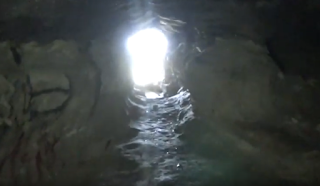Barton Creek Cave No. 1 is one of the lesser known caves of Austin/Travis County. This news article will explain the biology and geology behind Barton Creek Cave No. 1.
Barton Creek Cave No. 1 was discovered in spring of 1960 by Bill Russell and Roger Sorrells who were members of Texas Speleological Survey. They were the first people to have explored Barton Creek Cave No. 1. Both of them used a dead tree trunk to gain entry into Barton Creek Cave No. 1 for accessibility. (Ref: https://www.texasspeleologicalsurvey.org/PDF/TSS_Volume1/TSS%201(1)%20compressed.pdf)
A cliffside cave called Barton Creek Cave No. 1 is visible to the naked eyes from a far distance from Barton Creek in Barton Creek Preserve. Barton Creek Cave No. 1 is located on the Urban Assault Wall, a cliff above Barton Creek, The cave has a crawlway about 100 feet long and is about 30 feet above creek level on a cliff. The crawlway inside this cave is about 75 feet long in diameter. Barton Creek Cave No. 1 is difficult to enter to due to being on the wall of a cliff. Flowstone reaches within a few inches of ceiling. (Ref: https://www.tcmacaves.org/download/87/capital-caver/2056/the-capital-caver-4.pdf)
Barton Creek Cave No. 1 is located on the same cliff as Barton Creek Cave No. 2 and Barton Creek Cave No. 3. Barton Creek Cave No. 1 is about 30 feet south from Barton Creek Cave No. 2 and 80 feet above creek level. The cave ends in a flowstone bank and empties into Barton Creek.
Long legged spiders and tarantulas are the natural wildlife that inhabit Barton Creek Cave No. 1. The moist environment is breeding ground ideal for spiders. Many insects inhabit this cave as insects inhabit and compromise a huge portion of natural wildlife in the caves of Texas. The caves of Barton Creek Preserve are no exception. (Ref: https://digital.lib.usf.edu/SFS0051013/00001)
A sense of moisture can be felt inside of the cave. Sometimes on hot days during the summer, a sense of arid dryness can be felt inside of the cave. However that is ultimately rare as this cave is near a creek. The air is sometimes hot. Now the rock formation of this cave is native limestone. Many caves in Central Texas have a rock formation of native limestone.
Mixerr Reviews was a news blog/local business from Austin, Texas, US that operated from 2012 to 2023. This blog is no longer operational and has been discontinued since Michael Mixerr is currently a writer, narrator, and content curator for Bout Dat Online.
Monday, August 24, 2020
Exploring the history of Barton Creek Cave No. 1.
Subscribe to:
Post Comments (Atom)
No comments:
Post a Comment